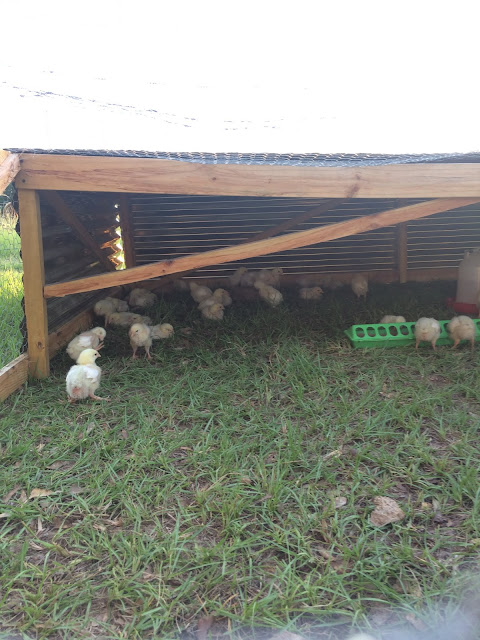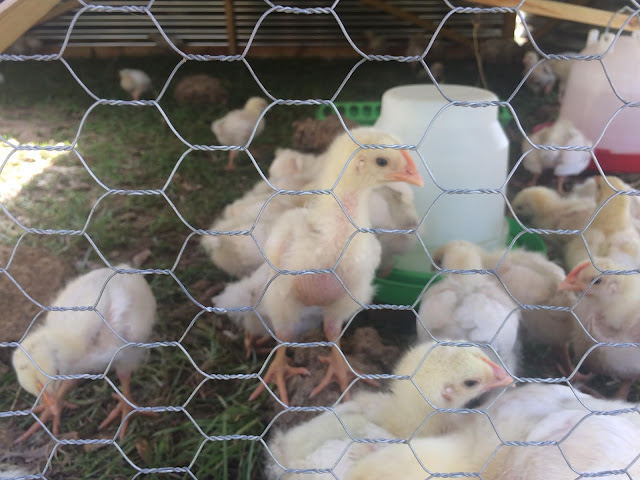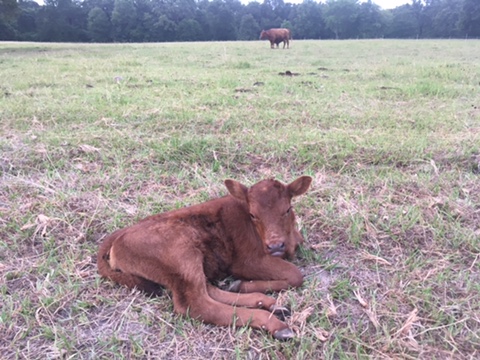The Cornish Cross chicks grew nicely for several weeks, despite the hot Texas summer heat that often was over 100 degrees in the shade. The daily routine involved moving the cage one length, filling the water bucket, and topping up the feed.
We had a casualty every few days, from causes unknown, but most likely from the heat. There wasn't much we could do about that. Son tried adding ice packs and frozen water bottles to the water bucket and around the cage to provide a slight chilling affect. He rotated the cage under the shade of trees as much as possible.
It was around week three or four, when a small pack of wild dogs starting causing trouble around our property. They were spotted on several occasions out in the pastures, near the woods, near the goats, and around the baby calves, usually around dusk. We did our best to run them off and discourage them, but they seemed determined to roam around and through our property. Several times we managed to shoot a few rounds in their direction.
Most likely, the dogs had started out as friendly domestic dogs that were unwanted and had been dumped off in the area. Over time, stray dogs gravitate towards each other, all desperately searching for food and water, and eventually the wild pack behavior is developed.
So it probably should have been expected that they would eventually find their way closer to the house and discover the cage of tender little chicks.
Every so often, Son would find a clump of feathers or a dead chick either inside or outside the coop. We guessed a predator or the wild dogs had snapped at them through the chicken wire, sometime in the night.
But early one morning around week seven, two of the wild dogs managed to get inside the coop somehow by gnawing and tearing away at the edges of the chicken wire. Once inside they went on a crazy killing spree. By the time Son could get out there with the rifle, most of the chickens were dead. He did manage to kill one of the dogs still inside the coop, and later tracked down the other one that had been injured.
Even though about 10 chicks somehow managed to survive, they never really recovered from the shock of the dog attack. A few eventually died. By week nine when it was processing time, there were seven chicks remaining. Five were a good size, and two were small, possibly females and naturally smaller.
We already had most of the processing equipment, having purchased it several years ago before we knew the difference between layers and broilers. The equipment includes killing cones, a large scalding pot, a large propane burner, and an electric plucker. The one essential thing we didn't really have was a good sharp knife.
I had made it clear from the beginning that I did not want to participate in the harvesting process. After all, he had read the book and watched all the videos. But when the time came he needed help, and I was the only one at home. He gathered all the equipment and set up most of it under the shade of an oak tree. He nailed the killing cones to the tree, set up the scalding pot on the gravel driveway, plugged in the plucker near the house, and set up a table in the shade. He had bought several bags of ice in town and used tubs for the chilling process. He did all the processing by himself, so I didn't have to help with that. My main contribution was moral support and also helping to set up the equipment that had never been used.
Once the chickens were cleaned and dressed, they were left in ice water for 3-4 hours to chill. Then they were put in plastic bags and put in the freezer. We later discovered that the best method is to chill the chicken for two days before freezing which should make the meat more tender. The average dressed weight was about 4 pounds. We have enough to taste test, at least.
Son is undeterred by the setback, and has already ordered more chicks for a fall batch of pastured chickens. He will repair the cage and attempt to make it more secure and safe from predators. He is researching ways to protect and guard the cage. We will also avoid a summer batch, and instead focus on fall and spring time.
The wild dog attack
The few survivors
Processing day
A few months ago, Son decided he'd like to start raising chickens for meat. He had heard about the Joel Salatin method, and read his book Pastured Poultry Profits.
To refresh your memory, chickens raised for eating are usually called broilers. Other terms like fryers or roasters are used interchangeably. This simply means they are suitable for broiling, frying or roasting. The breed of chicken is chosen for it's tenderness and ability to mature quickly. The average time from day old chick to harvesting is about eight weeks.
The first step was to build the cage. The book included instructions on how to build, and Son was able to assemble it in the back yard after buying the few necessary supplies.
The original plan made a cage 10'x12' to house 50-75 chicks. For the first effort we decided a smaller one would be more practical. So he built a 10'x10' cage for 40-60 chicks. The cage provided covered sections for shelter from sun and rain, open sections for light and ventilation, and a small hatch opening for access.
The Salatin model uses Cornish Rock Cross chickens, specifically bred to be fast growers and good meat (not for beauty, I might add). He ordered 55 male chicks from Murray McMurray Hatchery. He set up a small brooder in the garage, with deep litter and a warming light. But by the time the chicks arrived, the Texas summer heat had set in and he didn't need the light. In fact, the hot temperatures became a real problem and he ended up needing a fan at times to keep the chicks from getting too hot.
The chicks were moved outside at 12 days, the earliest possible age, in order to give them some relief from the hot, stuffy garage. But outside proved to be almost as hot, with temperatures for many days in July above 100 degrees.
Ideally the cage is moved once a day to a new grassy area, where the cows have recently grazed. The little chicks love the bugs that love cow poop and are often seen standing on top of a dry pile playing "King of the Mountain." The first few weeks were a challenge because several chicks would escape during the moving process and would have to be caught and put back inside.
The chicks were monitored closely to make sure they had access to plenty of clean water and the age appropriate feed.
Look for the second post about the rest of the process.
We had an opportunity to buy hay for the winter, so we bought 45 bales which were delivered in two loads. Guv'nor unloaded the bales with our tractor and stacked them where he would find them useful later.
Since then the price of hay has almost doubled.
This a guest post by our good friend Factor. He has a property just east of us that he bought several years ago and is raising Belted Galloways. On a recent visit to see us and check on his property, he happened to be on his property when two bulls were fighting. It sounded so interesting, I asked him to write a little about the incident and supply me with a few photos for my blog. I hope you find it as interesting as we did.
**********
When I established my herd of Belted Galloway cattle more than two years ago, Griff (the local man helping me manage them) moved his champion but older bull, Yoseph, to my property to be with them. I thought it was just for reproductive purposes but Griff said it was also for the comfort and protection of the younger and largely female cattle. Today, I tangibly found out why.
When I drove onto my property I found a very large Black Angus bull from my neighbor's ranch in the middle of my herd nosing around the heifers...much to Yoseph's chagrin. The rogue bull seemed unflustered by my presence, so I was able to observe from close proximity -- his focus was squarely on Yoseph.
The bull began textbook threat behavior, showing me and Yoseph his broadside view with his head down and back arched, pawing with his forefeet and sending dirt flying behind and over his back. It was both alarming and comforting that Yoseph did the same. They slowly approached each other and with a sudden surge they butted heads and began forcing each other back and forth in the pasture. Surprisingly the other cattle seemed completely nonplussed. I was concerned for Yoseph since he's older with hip bones and spine partially visible through the thinning hide across his back. Fortunately the flurry of grass, dust, and grunts ended quickly and neither bull seemed injured. And thankfully the victor was clear.
The rogue bull made his way, alone, back towards the breach in the fence and Yoseph escorted my (or should I say his) herd of 32 cattle calmly back into the pasture.
A few minutes later I drove into the pasture and Yoseph approached the truck. As if looking for congratulations, he passively stuck his nose in the passenger window coming nose-to-nose with my hopelessly little and wide-eyed Aussie, Linkin. I saw a very small cut above his left eye, the only evidence of the confrontation. He had won, as I'm sure he'd done many times before -- and he probably never had any doubt that he would.
We're not sure how this happened - well, we do know HOW it happened just not how they get through the fencing, but we have had eight calves born recently. We vaguely remember one of the bulls getting out of their area and visiting the cows awhile back. We didn't think much about it at the time. Now we know what he was up to. He was a busy boy.
It seemed like every day for a week or two there was a new calf out in the field. They are hard to see sometimes because they curl up in the tall grass and sleep most of the time.
Who knows how many other times one of the bulls went visiting when we weren't around. Guv'nor was trying to control the breeding process, but is ready to just let them graze together since the electric fencing doesn't seem to keep them apart.
I did my best to try to get a photo of them all together.























































